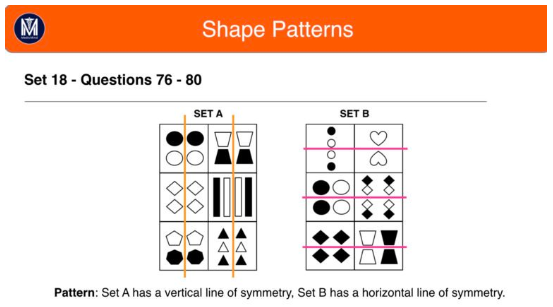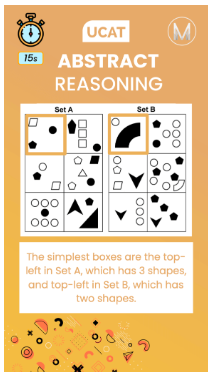PLEASE NOTE: As of 2025, candidates sitting the UCAT will no longer be required to take the Abstract Reasoning section. For more information, please see the official UCAT website.
The Abstract Reasoning section is considered one of the most challenging UCAT sections. It has a reputation among students for having confusing and tricky questions that take up a lot of precious time. Furthermore, the questions may look very different from the standard test questions you have seen previously in examinations. However, do not let this intimidate you!
As with other sections in the UCAT, you can master this section. All it requires is some systematic practice and understanding of the question format. Although the questions may seem random, remember there is always a pattern behind them! Understanding this would aid you a lot in mastering this section. Recognising the patterns and utilising them to respond to the other questions is all that is required. Hopefully, by following the six essential UCAT abstract reasoning tips in this article, you may begin to conquer the UCAT Abstract Reasoning portion!

1. Use UCAT Abstract Reasoning patterns tables
The UCAT Abstract Reasoning section tests your ability to spot patterns in seemingly random combinations of shapes. When you practise the UCAT Abstract Reasoning for the first time, the questions could seem completely incomprehensible. However, do keep in mind that there is always a pattern. Also, there are ultimately only a limited number of UCAT abstract reasoning patterns that may exist within the section. If you are unable to see the patterns when answering these questions, you can take note of all the possible patterns and apply them to the questions.
To record and organise the many patterns you encounter while preparing, you need to make a pattern table. You can tackle each question more methodically and find the most frequent patterns.
This method could seem tedious at first, but as you start to memorise the patterns, you will be able to move more quickly. Hopefully, with practice, you can answer questions more quickly and precisely.

The Abstract Reasoning UCAT section has four distinct question types. Understanding these question types and having strategies to approach each will ensure you understand the more challenging questions. The table below lists the four types of questions.
Four types of questions
| Question Type | Example |
| Set A, B or neither | There are two sets of shapes shown as Set A and Set B. These questions will show you additional test shapes and you need to decide if they belong to Set A, B or neither. |
| Sequence | There will be a sequence of four shapes that changes based on a specific pattern. You will then have to choose the next shape in the sequence. |
| Finish the statement | A question will be displayed with an incomplete statement: Shape A is to Shape B as Shape X is to Shape ? You will then need to choose the image that completes this statement. |
| Set A or B | There are two sets of shapes shown as Set A and Set B. The question asks you to select a shape that belongs to either Set A or Set B. |
2. Memorise key triggers
You will learn more about the various UCAT Abstract Reasoning question types as you study for this section. Eventually, you will realise that various patterns have a few distinct characteristics. This will help you to identify the common traits between types of questions and focus your attention on common patterns. This method will allow you to discover the underlying pattern more quickly.
For example, if you see crescent moons in the question, this could trigger you to search for a pattern based on curved and straight shapes. This is because there are not many shapes with curved lines. Hence, if you see a shape with curved lines, the curved component is probably crucial to the pattern.
If you see a lot of overlapping shapes, this should trigger you to look for a pattern based on the number of intersections between the overlapping shapes. Alternatively, if the question has multiple pairs of shapes, this could trigger you to think about a pattern with a line of symmetry. This is shown in the image below.

Pattern table
Another of our Abstract Reasoning UCAhen you start recognising triggers, add them to your pattern table to help you remember what to look for. This is one of the best tips to help increase your speed, as you can already narrow the possible patterns in front of you. As a start, the following are a few regular patterns to watch out for:
- Shape: Look out for when a particular shape repeats within the set or if all the shapes in a set share a particular feature e.g even number of sides
- Position: Try to spot if a particular shape is always in a certain place within the box e.g right upper corner or placed between two other shapes
- Rotation: Consider if a shape is rotating within a set pattern e.g clockwise
3. Choosing appropriate resources
The key to succeeding in the UCAT Abstract Reasoning is practice and familiarity with the question categories. To become familiar with the kinds of questions that you would get on your examination day, you need to have access to relevant sources.
Some great examples of sources are books containing UCAT practice questions. However, bear in mind that occasionally these practice questions might be more difficult than those on the actual UCAT. For example, the ISC 1250 book is considered very difficult. Even though some students could find this preparation helpful, others might find it intimidating and off-putting.
You could benefit from working with one of our one-on-one UCAT tutors if you are having trouble with the UCAT Abstract Reasoning section. They can walk you through our large question bank, assisting you in spotting trends, and they can tailor the sessions to meet your exact needs.
4. Abstract Reasoning – timing tips
The UCAT Abstract Reasoning part is the quickest – only 12 minutes – but it also features the most questions – a staggering 50. You must be aware of how much time (or rather, how little!) you have for each question and that you keep track of it. On exam day, especially if you have not extensively prepared ahead of it, it is incredibly easy to become stuck on the difficult questions and run out of time.
This section also contains a variety of question types. Depending on the type of question, you should adjust how much time you spend answering it.
To be specific, there are two broad types of questions for this section. The first type of questions, Type 1, ask 5 questions for only 1 set of patterns given. The other type of question, Type 2, only gives 1 question per set of patterns. There is one pattern and five corresponding questions for Type 1 questions. To avoid getting stuck on these lower yield problems (Type 2), you should adjust how long you spend searching for the pattern. Ideally, you should only spend 1 minute for the five Type 1 questions, and 14 seconds for each Type 2 question.
| Type 1 Questions | Type 2 Questions |
| 1 Pattern | 1 Pattern |
| 5 questions per set | 1 question per set |
| 1 minute per pattern | 14 seconds per pattern |
5. Know when to move on
The UCAT Abstract Reasoning section is extremely challenging, and it is easy to get carried away and spend longer than necessary attempting to answer complex problems. It is important to acknowledge that some designs are ultimately just too challenging, despite their deliberate design!
To slow test-takers down, they are given difficult questions with extremely detailed and complicated patterns. Candidates who cannot recognise a question as being above their ability will waste time attempting to figure it out in the allocated time. If you come across a question like this, answer it as best you can and go on. You can even give a random guess if you are not making any headway! You can better spend your time on other questions, and you will get a higher grade by using your time to solve questions you are able to answer.
Keep in mind that the UCAT does not practice negative marking, so there is no harm in guessing to move on to the other questions in the section. In the UCAT, you should never leave a question blank – even if your answer is only a guess! This is because you still have a 25% chance to get it right, even if you have no idea how to solve the question.
6. Always start with the simplest box
When the question shows two sets of patterns, you should always look at the box with the fewest number of shapes in each set. This will prevent you from becoming sidetracked and allow you to compare each set properly.
The box with the fewest forms is not usually the one that is the simplest. Also possible are:
- the box with the fewest colour variations e.g. striped, black etc.
- the box with an obvious pattern e.g. a very large shape
- the box with repeating units e.g. 4 triangles
An example of such boxes are as illustrated in the image below.

If you’re looking for more information on the UCAT score, check out our UCAT conversion table.
FAQs
→What is the Abstract Reasoning section of the UCAT?
The Abstract Reasoning section of the UCAT assesses your ability to identify patterns and relationships between shapes and figures.
→What should I expect during the Abstract Reasoning section of the UCAT?
During the Abstract Reasoning section of the UCAT, questions will include a series of shapes and figures, and you will need to identify patterns and relationships between them. You will then need to apply these patterns and relationships to a new set of figures.
→How long is the UCAT Abstract Reasoning?
You have 13 minutes for the Abstract Reasoning section. This phase is the most time-constrained since you only have 13 minutes to answer 55 questions. Avoid spending too much time on the toughest questions since you would be better off using that time on questions that are simpler and would get you more points.
→What are some tips for preparing for the Abstract Reasoning section of the UCAT?
It is important to practice identifying patterns and relationships between shapes and figures. You can do this by working through practice questions and timed tests.
→What is a good UCAT Abstract Reasoning score?
The UCAT Abstract Reasoning section’s typical score in 2020 was 653. Anything higher than this will place you among the top half of all test takers. Keep in mind that colleges typically consider your UCAT score overall, so a strong result here can offset a lower performance in other parts.
→Are there any common mistakes that students make on the Abstract Reasoning section of the UCAT?
One common mistake that students make on the Abstract Reasoning section of the UCAT is to overcomplicate the figures and look for complex patterns or relationships that are not present. It is important to focus on identifying simple shapes and patterns that can be applied consistently across the figures.
→Are there any resources available to help me prepare for the Abstract Reasoning section of the UCAT?
Many resources are available to help you prepare for the Abstract Reasoning section of the UCAT, including online practice tests and question banks, study guides and textbooks, and tutoring or coaching services.



